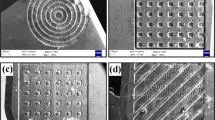Abstract
The grinding performance is defined significantly by grinding wheel preparation. Besides the required grinding wheel profile, the dressing process must produce appropriate wheel topography. Resultant wheel topography influences the workpiece surface roughness and surface morphology by the number and shape of the kinematical edges, the pore volume, and the wear behavior of the abrasive layer. Grinding is recognized as one of the most environmentally unfriendly manufacturing processes. The use of minimum quantity lubrication (MQL) is of great significance in conjunction between large cutting fluids application and dry machining. In this study, for the first time, the effect of dressing parameters and wheel topography on MQL grinding performance of soft steel is investigated. In other words, to generate different grinding wheel topographies, depth of dressing and dressing speed have been changed during dressing and conditioning of vitrified Al2O3 wheels using single-point diamond dresser. After dressing of grinding wheels, machining tests have been conducted to study the influence of the wheel topography and coolant-lubricant types on the performance of grinding operation. Performance indicators included the following: workpiece surface quality, grinding forces, and wheel loading. The tests have been performed in the presence of fluid, MQL with compressed air, MQL with argon, as well as, in dry condition. The results indicate that enhanced grinding performance can be obtained while grinding under MQL with argon and compressed air and finer dressing conditions in comparison to other coolant-lubricant environments.
Similar content being viewed by others
References
Tawakoli T, Hadad MJ, Sadeghi MH, Daneshi A, Stöckert S, Rasifard A (2009) An experimental investigation of the effects of workpiece and grinding parameters on minimum quantity lubrication-MQL grinding. Int J Mach Tools Manuf 49:924–932
Tawakoli T, Hadad MJ, Sadeghi MH (2010) Influence of oil mist parameters on minimum quantity lubrication–MQL grinding process. Int J Mach Tools Manuf 50:521–531
Tawakoli T, Hadad MJ, Sadeghi MH (2010) Investigation on minimum quantity lubricant-MQL grinding of 100Cr6 hardened steel using different abrasive and coolant–lubricant types. Int J Mach Tools Manuf 50:698–708
Tawakoli T, Hadad MJ, Sadeghi MH, Daneshi A, Sadeghi B (2011) Minimum quantity lubrication in grinding: effects of abrasive and coolant-lubricant types. J Clean Prod 19:2088–2099
Sadeghi MH, Haddad MJ, Tawakoli T, Emami M (2009) Minimal quantity lubrication-MQL in grinding of Ti-6Al-4V titanium alloy. Int J Adv Manuf Technol 44:487–500
Sadeghi MH, Hadad MJ, Tawakoli T, Vesali A, Emami M (2010) An investigation on surface grinding of AISI 4140 hardened steel using minimum quantity lubrication-MQL technique. Int J Mater Form 3:241–251
Tawakoli T, Hadad MJ, Daneshi A, Sadeghi MH, Sadeghi B (2011) Study on the effects of abrasive and coolant-lubricant types on minimum quantity lubrication-MQL grinding. Adv Mater Res 325:231–237
Hadad MJ, Tawakoli T, Sadeghi MJ, Sadeghi B (2012) Temperature and energy partition in minimum quantity lubrication-MQL grinding process. Int J Mach Tools Manuf 54-55:10–17
Hadad MJ (2010) Minimum Quantity Lubrication-MQL grinding process & investigation of surface quality. Ph.D. Thesis, Manufacturing Engineering Division, School of Engineering, Tarbiat Modares University; Tehran, Iran
Hadad MJ, Sadeghi B (2012) Thermal analysis of minimum quantity lubrication-MQL grinding process. Int J Mach Tools Manuf 63:1–15
Rabiei F, Rahimi AR, Hadad MJ, Ashrafijou M (2015) Performance improvement of minimum quantity lubrication (MQL) technique in surface grinding by modeling and optimization. J Clean Prod 86:447–460
Dixit US, Sarma DK, Davim JP (2012) Environmentally friendly machining. Springer-Verlag, New York, USA
Malkin S, Guo C (2008) Grinding technology: theory and applications of machining with abrasives, 2nd edn. Industrial Press Inc., New York, USA
Marinescu ID, Hitchiner M, Uhlmann E, Rowe WB, Inasaki I (2007) Handbook of machining with grinding wheels. CRC Press, Taylor & Francis Group
Linke B (2007) Wirkmechanismen beim Abrichten keramisch gebundener Schleifscheiben. Doctoral thesis, Aachen University
Linke B (2008) Dressing process model for vitrified bonded grinding wheels. CIRP Ann-Manuf Technol 57:345–348
Linke B, Klocke F (2010) Temperatures and wear mechanisms in dressing of vitrified bonded grinding wheels. Int J Mach Tools Manuf 50:552–558
Wimmer J (1995) Konditionieren hochharter Schleifscheiben zum Schleifen von Hochleistungskeramik. Doctoral Thesis, University of Kaiserslautern
Liebe I (1996) Auswahl und Konditionierung von Werkzeugen für das Außenrund-Profilschleifen technischer Keramiken. Doctoral Thesis, TU Berlin
Hadad MJ (2015) An experimental investigation of the effects of machining parameters on environmentally friendly grinding process. J Clean Prod 108:217–231
Minke E (1988) Grundlagen der Verschleiss ausbildung an nicht-rotierenden Abrichtschneiden zum Einsatz an konventionellen Schleifwerkzeugen. Doctoral Thesis, University of Bremen
Author information
Authors and Affiliations
Corresponding author
Rights and permissions
About this article
Cite this article
Hadad, M., Sharbati, A. Analysis of the effects of dressing and wheel topography on grinding process under different coolant-lubricant conditions. Int J Adv Manuf Technol 90, 3727–3738 (2017). https://doi.org/10.1007/s00170-016-9703-0
Received:
Accepted:
Published:
Issue Date:
DOI: https://doi.org/10.1007/s00170-016-9703-0




